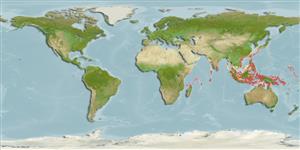>
Ovalentaria/misc (Various families in series Ovalentaria) >
Pomacentridae (Damselfishes) > Pomacentrinae
Etymology: Neoglyphidodon: Greek, para = the side of + Greek, glyphis = carved + Greek, odous = teeth.
More on author: Bleeker.
Environment: milieu / climate zone / depth range / distribution range
Ecologia
marinhas associadas(os) a recifes; não migratória; intervalo de profundidade 1 - 20 m (Ref. 7247). Tropical; 45°N - 14°S
Indo-West Pacific: Sri Lanka to the Indo-Australian Archipelago including Sumatra, Java, Sulawesi, and the Solomon Islands. Records from other locations are mostly misidentifications.
Tamanho / Peso / Idade
Maturity: Lm ? range ? - ? cm
Max length : 13.5 cm TL macho/indeterminado; (Ref. 90102)
Espinhos dorsais (total): 13; Raios dorsais (total): 15-16; Espinhos anais 2; Raios anais : 13 - 15.
Adults inhabit coral reefs (Ref. 9710), probably subject to surge to 20 m depth. Poorly known species that is seldom seen. Probably overlooked because of the drab appearance. Juveniles unknown and probably have large ocellus like N. thoracotaeniatus (Ref. 48636). Life history characteristics for the family specify that this group is oviparous, with distinct pairing during breeding (Ref. 205). Eggs are demersal and adhere to the substrate (Ref. 205). Males guard and aerate the eggs (Ref. 205). Diurnal species (Ref. 113699).
Ciclo de vida ou comportamento de acasalamento
Maturidade | Reprodução | Desova | Ovos | Fecundidade | Larvas
Life history characteristics for the family specify that this group is oviparous, with distinct pairing during breeding (Ref. 205). Eggs are demersal and adhere to the substrate (Ref. 205). Males guard and aerate the eggs (Ref. 205).
Allen, G.R., 1991. Damselfishes of the world. Mergus Publishers, Melle, Germany. 271 p. (Ref. 7247)
Status na Lista Vermelha da UICN (Ref. 130435)
Ameaça para os humanos
Harmless
Uso pelos humanos
Warning: mysqli::__construct(): (HY000/1040): Too many connections in /var/www/html/includes/func_getlabel.php on line 46
Can't connect to MySQL database (fbapp). Errorcode: Too many connections
